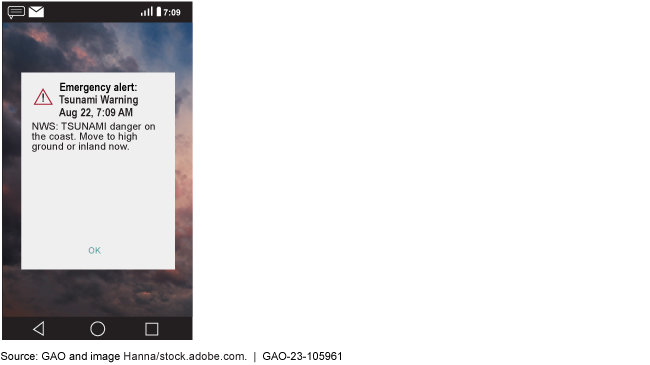Emergency Alerts: NOAA Should Take Additional Actions to Help Ensure Tsunami Alerts Reach Those at Risk
Fast Facts
It's critical that the public receive alerts about destructive tsunamis. The National Oceanic and Atmospheric Administration sends tsunami alerts to the public via:
Emergency broadcast messages on TV and radio
Emergency texts on mobile devices
Social media posts and website alerts
NOAA has taken steps to improve how it alerts the public, such as updating its website to allow easy access to critical information during tsunamis. But the agency needs to ensure that the alerts are reaching at-risk populations in Tribal, rural, and remote areas. Our recommendations address this issue and more.
Emergency texts, as shown, warn the public of impending tsunami dangers

Highlights
What GAO Found
The National Oceanic and Atmospheric Administration (NOAA) primarily uses three methods to send tsunami alerts to the public (see figure):
- NOAA Weather Radio delivers alerts to listeners and to the Emergency Alert System, the nationwide system for broadcasting emergency messages over television, radio, and cable systems;
- the Integrated Public Alert and Warning System (IPAWS) delivers alerts through various pathways, including via Wireless Emergency Alerts—text-like messages on people's mobile devices; and
- the internet contains alerts on NOAA's website and social media posts.
The Federal Emergency Management Agency (FEMA) operates IPAWS and the Federal Communications Commission (FCC) sets rules and standards for wireless providers and broadcasters that participate in emergency alerting.
National Oceanic and Atmospheric Administration's (NOAA) Primary Methods for Disseminating Tsunami Alerts to the Public

NOAA has taken steps to address some tsunami alerting challenges, but GAO found opportunities for improvement. For example, NOAA has efforts underway to improve its website to allow users to more easily access critical information during tsunamis and to better target tsunami alerts to at-risk populations. GAO found that NOAA could improve its tsunami alerting by taking the following actions:
- Assessing the extent of NOAA Weather Radio's coverage of populated areas at risk of tsunamis. NOAA Weather Radio is a critical tool to broadcast tsunami alerts, especially in tribal, remote, and rural areas, yet NOAA lacks assurance that tsunami alerts are reaching these areas. Assessing the extent of NOAA Weather Radio coverage would help NOAA and others understand whether at-risk communities have access to a key alerting method.
- Enhancing collaborative efforts with FCC and FEMA to determine how to use IPAWS to deliver tsunami alerts to the Emergency Alert System. Using IPAWS in this way would have many benefits, such as allowing tsunami alerts to be sent in multiple languages and to include additional information such as maps and video.
Why GAO Did This Study
Tsunamis are powerful, destructive, and capable of striking any U.S. coast, making it critical that the public is alerted to tsunami hazards. NOAA has primary responsibility for sending tsunami alerts to the public.
GAO was asked to review NOAA's tsunami alerting system. This report examines (1) NOAA's primary methods for sending tsunami alerts to the public, and (2) the extent to which NOAA has addressed related challenges and opportunities for improvement.
GAO reviewed NOAA and other federal documentation and interviewed NOAA, FCC, and FEMA officials. GAO identified challenges NOAA faces and opportunities for improvement by reviewing advisory reports and interviewing a non-generalizable selection of stakeholders including tribal representatives, state and local emergency managers, industry associations, and a consumer group. GAO compared NOAA's efforts to selected key collaboration practices and federal internal control standards.
Recommendations
GAO is recommending that NOAA (1) assess NOAA Weather Radio's coverage of populated areas at risk of tsunamis and (2) collaborate with FCC and FEMA to determine how to use IPAWS to deliver tsunami alerts to the Emergency Alert System. NOAA concurred with GAO's recommendations.
Recommendations for Executive Action
| Agency Affected | Recommendation | Status |
|---|---|---|
| National Oceanic and Atmospheric Administration | The NOAA Administrator should assess the extent to which NOAA Weather Radio coverage extends to populated areas at risk of tsunamis, and publicly communicate the results of the assessment. (Recommendation 1) |
In 2024, we confirmed that NOAA produced maps for the U.S. Pacific and Alaskan coasts of combined tsunami risk areas with overlays of the NOAA Weather Radio coverage areas for all of its weather radio transmitters. NOAA acknowledged that maps of NOAA Weather Radio coverage and tsunami risk overlays for populated areas along coastlines are a crucial part of planning and preparedness by local authorities and jurisdictions. Moreover, through a public information statement released in July 2024, NOAA notified the public, its partners, and other stakeholders about the maps and encouraged the use of these maps for emergency planning and preparedness by local authorities and jurisdictions and for residents of these coastal communities. By doing so, NOAA and others have a better understanding of whether at-risk communities have access to NOAA Weather Radio, which is a key tsunami alerting method.
|
| National Oceanic and Atmospheric Administration | The NOAA Administrator, in collaboration with FCC and FEMA, should clarify and document the agencies' responsibilities and a decision-making process for determining how to use IPAWS to deliver tsunami alerts to EAS. (Recommendation 2) |
NOAA agreed with the recommendation. As of March 2024, NOAA officials informed us that the agency was holding monthly meetings with FCC and FEMA to discuss requirements for how to use IPAWS to deliver tsunami alerts to EAS. NOAA expects full implementation of this recommendation by December 2025.
|
